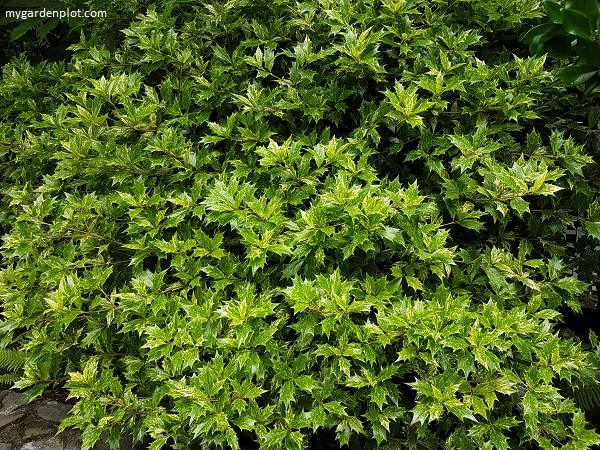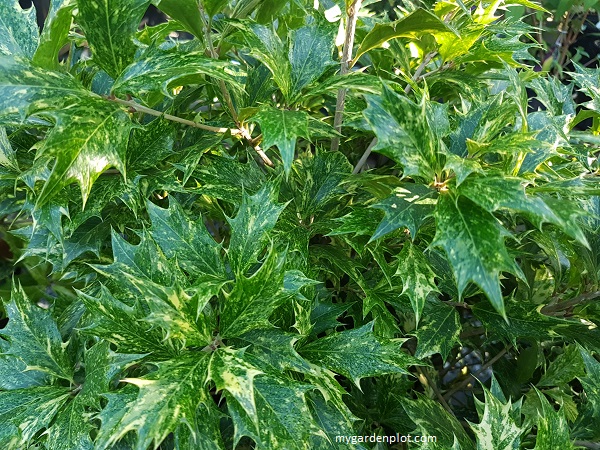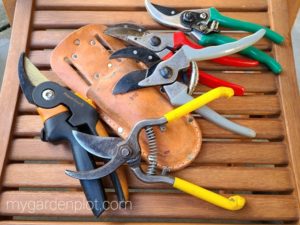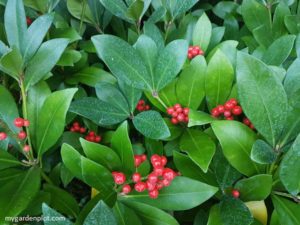About Osmanthus heterophyllus (False Holly, Holly Osmanthus, Holly Tea Olive, Mock Holly, Japanese False Holly, Holly Leaf Osmanthus)
Osmanthus heterophyllus, better known as False Holly (plus a few other name variations – see above), is a look-alike to the well-known Ilex (Holly) – a winter favourite for Christmas decorations. False holly has a similarly bold and spiny leaf texture as the Christmas holly. It is native to Japan and Taiwan. False holly is a sturdy, dense evergreen plant suitable for a shrub border, as hedging or screening. Though similar to the Christmas holly, skimmia and aucuba, the false holly is a dioecious plant. This means a male plant is needed to pollinate the female to produce berries. The small fragrant white flowers are not prominent and bloom in autumn. The sparse purple-black fruit look like olive berries. False holly berries are not edible. False hollies do not set fruit in cultivation. It is mostly grown for its attractive foliage. Learn how to grow, care and prune false holly.
Some have called the false holly, ‘fake holly’. While it has similar attributes as the true holly, using the word ‘fake’ implies it is inferior. Nothing is further from the truth. False holly is an attractive, elegant, easy care and non invasive shrub that never fails to impressive, especially the Osmanthus heterophyllus ‘Goshiki’. See below for recommended false holly varieties.
False Holly At A Glance
Type: Broadleaf Evergreen Shrub
Location: Full Sun / Part Shade
Seasonal Interest: Year-Round Foliage, Late Summer / Autumn Flowers
When To Prune: Mid / Late Spring (see pruning details below)
Size: Varies 3-6 metres (10-20 ft) tall
Plant Hardiness Zones: 7, 8, 9 (planted in zone 6 will need some winter protection)
Where To Plant And How To Grow False Holly
False hollies are low maintenance, adaptable and easy to grow in most conditions, such as urban pollution and coastal areas. It thrives in fertile, well-drained soil in sunny to partially sunny locations. A sunny east-facing or sunny west-facing location that receives a little shade either morning or afternoon is perfect. If planted in full shade, the false holly will grow but foliage colour contrast will be reduced. False holly is an acid-loving plant but can tolerate most soil types. Though it will not flourish being in constantly wet soil year round.
False holly does not have an aggressive root system as the true holly shrub. It can be planted next to a window so the fragrant scent from the flowers can be enjoyed indoors too.
For colder regions (zones 6 or 7), the false holly is best planted in a protected area away from cold winter winds. Planted next to the house and under an overhang will provide some insulation and protect the shoots from damage caused by severe winter weather.
False holly can be used successfully in container gardening, as it is easy to contain to the size you need. However, in colder regions (zones 6 or 7), the false holly planted in a garden pot will also need some protection. As it sits above ground, this exposes the roots to any severe cold weather.
When To Plant And How To Care For False Holly
Plant in spring or autumn and water regularly during its first growing season. Once established, false holly is somewhat drought tolerant, but it is best to water deeply once a week during the hot summer months.
Apply a balanced fertilizer and mulch lightly in spring before the growing season starts.
When And How To Prune False Holly
False holly does not generally need regular pruning, though it responds well to hard pruning if required and it is very suitable for hedging. It is a slow-growing shrub with a natural upright oval habit. Any trimming or reshaping should be done mid to late spring. It is okay to prune in summer too but depending on how much you are taking off, it may remove the flower buds that are forming for the following year.
In spring, check and remove damaged limbs. Consider pruning any vigorous shoots in a young false holly to keep an evenly portioned shape. Balance the growth by cutting back the vigorous shoots about halfway to a healthy bud or side shoot.
Keep in mind that false holly is a slow grower, and you should only expect about 5-10 cm (2-4 in) of growth in a year. Once the false holly matures, the growth rate may slow down even more, making it a perfect low maintenance plant for a garden bed.
When pruning, use thorn-proof gloves – though this is only really needed for protection against the older leaves and any hard pruning. The younger foliage is relatively soft and gloves may not be needed.

Tools Needed For Pruning False Holly
Below is the list of essential tools needed to prune false holly. These shrubs benefit for pruning to develop a bushy and well-balanced form.
- Pruners – Bypass pruners are the most popular choice for gardeners and a must in a pruner’s tool kit. Bypass means the blades pass each other in a scissorlike action providing a clean cut without splintering the stem’s edge. The anvil-type pruner, where the upper blade cuts against a lower flat edge, must always be kept sharp. It is best for removing any dead thin stems from the false holly.
- Long-handled Loppers – These are similar to pruners but with long handles. These are heavy-duty and great for more challenging stems that may be hard to reach or too thick for pruners. This will make your pruning easier for taller shrubs.
- Pruning Saw – Saws are useful for thick stems that are growing close together. A Grecian saw or Japanese-blade pruning saw is a handsaw with a curved or straight edge that works with a pull-stroke action, especially when removing thick stems from a mature false holly.
- Shears – You will need a standard pair of shears if you grow your false holly as an evergreen hedge or topiaries. Some have a notch at the base of the blade that enables cutting thicker stems.
- Thorn-proof Gloves – This is optional as regular garden gloves work for false holly too. The young false holly leaves are not as prickly as the regular holly bush. Though you may find the long forearm protection with thorn-proof gloves makes the pruning job more comfortable.
Buyer's Guide To Hand Pruners (Pruning Shears, Secateurs)
RELATED TOPIC: Buyer’s Guide How To Choose A Pruning Saw (Garden Handsaw)
False Holly Recommendations
O. heterophyllus ‘Goshiki’ False Holly: ‘Goshiki’ means five colours in Japanese. The variegated holly-like foliage is attractive with its multiple shades of cream, green, pink, orange, and yellow adds year-round interest. It is hardy and adaptable and grows to about 2.5 m (8 ft) tall.
O. heterophyllus ‘Party Lights’ False Holly: The dark green foliage of the ‘Party Lights’ is a stable colour that sets a contrast for the new leaf growth that emerges as pink and cream at the end of each stem in spring. Perfect as a specimen plant for a spring garden. It grows to about 1.5 m (5 ft) tall.
O. heterophyllus ‘Gulftide’ False Holly: The ‘Gulftide’ is recommended as a screen or for hedging. It is dense and one of the hardiest varieties. The flossy foliage is deep green. It grows to about 2m (6 ft) and prunes easily for hedging or in an outdoor planter.
O. heterophyllus ‘Kembu’ False Holly: The foliage of the ‘Kembu’ is narrower. The green leaf has a cream edging. It generally has fewer spines on its leaves than other false hollies and seems to be slow-growing. The Kembu false holly grows to about 1.5 m (5 ft) tall. ‘Kembu’ means sword dance in Japanese.







